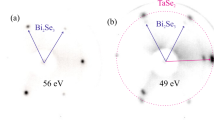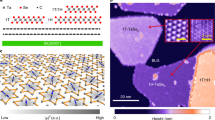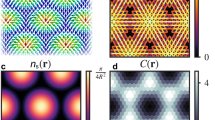Abstract
Control of the phase transition from topological to normal insulators can allow for an on/off switching of spin current. While topological phase transitions have been realized by elemental substitution in semiconducting alloys, such an approach requires preparation of materials with various compositions. Thus it is quite far from a feasible device application, which demands a reversible operation. Here we use angle-resolved photoemission spectroscopy and spin- and angle-resolved photoemission spectroscopy to visualize the strain-driven band-structure evolution of the quasi-one-dimensional superconductor TaSe3. We demonstrate that it undergoes reversible strain-induced topological phase transitions from a strong topological insulator phase with spin-polarized, quasi-one-dimensional topological surface states, to topologically trivial semimetal and band insulating phases. The quasi-one-dimensional superconductor TaSe3 provides a suitable platform for engineering the topological spintronics, for example as an on/off switch for a spin current that is robust against impurity scattering.
This is a preview of subscription content, access via your institution
Access options
Access Nature and 54 other Nature Portfolio journals
Get Nature+, our best-value online-access subscription
$29.99 / 30 days
cancel any time
Subscribe to this journal
Receive 12 print issues and online access
$259.00 per year
only $21.58 per issue
Buy this article
- Purchase on Springer Link
- Instant access to full article PDF
Prices may be subject to local taxes which are calculated during checkout




Similar content being viewed by others
Data availability
The data that support the findings of this study are available from the corresponding author upon request.
Change history
23 June 2021
A Correction to this paper has been published: https://doi.org/10.1038/s41563-021-01056-6
References
Fu, L., Kane, C. L. & Mele, E. J. Topological insulators in three dimensions. Phys. Rev. Lett. 98, 106803 (2007).
Fu, L. & Kane, C. L. Topological insulators with inversion symmetry. Phys. Rev. B 76, 045302 (2007).
Hasan, M. Z. & Kane, C. L. Colloquium: topological insulators. Rev. Mod. Phys. 82, 3045 (2010).
Qi, X.-L. & Zhang, S.-C. Topological insulators and superconductors. Rev. Mod. Phys. 83, 1057 (2011).
Ando, Y. Topological insulator materials. J. Phys. Soc. Jpn 82, 102001 (2013).
Xu, S.-Y. et al. Topological phase transition and texture inversion in a tunable topological insulator. Science 332, 560–564 (2011).
Sato, T. et al. Unexpected mass acquisition of Dirac fermions at the quantum phase transition of a topological insulator. Nat. Phys. 7, 840–844 (2011).
Xu, S.-Y. et al. Observation of a topological crystalline insulator phase and topological phase transition in Pb1–xSnxTe. Nat. Commun. 3, 1192 (2012).
Brahlek, M. et al. Topological-metal to band-insulator transition in (Bi1–xInx)2Se3 thin films. Phys. Rev. Lett. 109, 186403 (2012).
Zhang, J. et al. Topology-driven magnetic quantum phase transition in topological insulators. Science 339, 1582–1586 (2013).
Wu, L. et al. A sudden collapse in the transport lifetime across the topological phase transition in (Bi1–xInx)2Se3. Nat. Phys. 9, 410–414 (2013).
Xu, S.-Y. et al. Unconventional transformation of spin Dirac phase across a topological quantum phase transition. Nat. Commun. 6, 6870 (2015).
Monceau, P. Electronic crystals: an experimental overview. Adv. Phys. 61, 325–581 (2012).
Sambongi, T. et al. Superconductivity in one-dimensional TaSe3. J. Phys. Soc. Jpn 42, 1421–1422 (1977).
Stolyarov, M. A. et al. Breakdown current density in h-BN-capped quasi-1D TaSe3 metallic nanowires: prospects of interconnect applications. Nanoscale 8, 15774–15782 (2016).
Liu, G. et al. Low-frequency electronic noise in quasi-1D TaSe3 van der Waals nanowires. Nano Lett. 17, 377–383 (2017).
Nie, S. et al. Topological phases in the TaSe3 compound. Phys. Rev. B 98, 125143 (2018).
Fu, L. & Berg, E. Odd-parity topological superconductors: theory and application to CuxBi2Se3. Phys. Rev. Lett. 105, 097001 (2010).
Sasaki, S. et al. Topological superconductivity in CuxBi2Se3. Phys. Rev. Lett. 107, 217001 (2011).
Wang, M.-X. et al. The coexistence of superconductivity and topological order in the Bi2Se3 thin films. Science 336, 52–55 (2012).
Mourik, V. et al. Signatures of Majorana fermions in hybrid superconductor-semiconductor nanowire devices. Science 336, 1003–1007 (2012).
Sakano, M. et al. Topologically protected surface states in a centrosymmetric superconductor β-PdBi2. Nat. Commun. 6, 8595 (2015).
Guan, S.-Y. et al. Superconducting topological surface states in the noncentrosymmetric bulk superconductor PbTaSe2. Sci. Adv. 2, e1600894 (2016).
Zhang, P. et al. Observation of topological superconductivity on the surface of an iron-based superconductor. Science 360, 182–186 (2018).
Clark, O. J. et al. Fermiology and superconductivity of topological surface states in PdTe2. Phys. Rev. Lett. 120, 156401 (2018).
Liu, W. et al. A new Majorana platform in an Fe-As bilayer superconductor. Nat. Commun. 11, 5688 (2020).
Yuan, Y. et al. Evidence of anisotropic Majorana bound states in 2M-WS2. Nat. Phys. 15, 1046–1051 (2019).
Perucchi, A. et al. Spectroscopic and dc-transport investigations of the electronic properties of TaSe3. Eur. Phys. J. B 39, 433–440 (2004).
Chen, C. et al. Observation of topological electronic structure in quasi-1D superconductor TaSe3. Matter 3, 2055–2065 (2020).
Flötotto, D. et al. In situ strain tuning of the Dirac surface states in Bi2Se3 films. Nano Lett. 18, 5628–5632 (2018).
Kostylev, I., Yonezawa, S., Wang, Z., Ando, Y. & Maeno, Y. Uniaxial-strain control of nematic superconductivity in SrxBi2Se3. Nat. Commun. 11, 4152 (2020).
Mutch, J. et al. Evidence for a strain-tuned topological phase transition in ZrTe5. Sci. Adv. 5, eaav9771 (2019).
Zhang, P. et al. Observation and control of the weak topological insulator state in ZrTe5. Nat. Commun. 12, 406 (2021).
Riccò, S. et al. In situ strain tuning of the metal-insulator-transition of Ca2RuO4 in angle-resolved photoemission experiments. Nat. Commun. 9, 4535 (2018).
Tritt, T. M., Stillwell, E. P. & Skove, M. J. Effect of uniaxial stress on the transport properties of TaSe3. Phys. Rev. B 34, 6799 (1986).
Nomura, A. et al. Emergence of a resistance anomaly by Cu-doping in TaSe3. EPL 119, 17005 (2017).
Yaji, K. et al. High-resolution three-dimensional spin- and angle-resolved photoelectron spectrometer using vacuum ultraviolet laser light. Rev. Sci. Instrum. 87, 053111 (2016).
Tusche, C., Krasyuk, A. & Kirschner, J. Spin resolved bandstructure imaging with a high resolution momentum microscope. Ultramicroscopy 159, 520–529 (2015).
Noguchi, R. et al. Direct mapping of spin and orbital entangled wave functions under interband spin-orbit coupling of giant Rashba spin-split surface states. Phys. Rev. B 95, 041111 (2017).
Perdew, J. P. et al. Restoring the density-gradient expansion for exchange in solids and surfaces. Phys. Rev. Lett. 100, 136406 (2008).
Kresse, G. & Joubert, D. From ultrasoft pseudopotentials to the projector augmented-wave method. Phys. Rev. B 59, 1758 (1999).
Kresse, G. & Hafner, J. Ab initio molecular dynamics for liquid metals. Phys. Rev. B 47, 558 (1993).
Kresse, G. & Hafner, J. Ab initio molecular-dynamics simulation of the liquid-metal–amorphous-semiconductor transition in germanium. Phys. Rev. B 49, 14251 (1994).
Kresse, G. & Furthmüller, J. Efficiency of ab-initio total energy calculations for metals and semiconductors using a plane-wave basis set. Comput. Mater. Sci. 6, 15–50 (1996).
Kresse, G. & Furthmüller, J. Efficient iterative schemes for ab initio total-energy calculations using a plane-wave basis set. Phys. Rev. B 54, 11169 (1996).
Tran, F. & Blaha, P. Accurate band gaps of semiconductors and insulators with a semilocal exchange-correlation potential. Phys. Rev. Lett. 102, 226401 (2009).
Blaha, P. et al. WIEN2k: An Augmented Plane Wave Plus Local Orbitals Program for Calculating Crystal Properties (Technische Universität Wien, 2018).
Marzari, N. & Vanderbilt, D. Maximally localized generalized Wannier functions for composite energy bands. Phys. Rev. B 56, 12847 (1997).
Souza, I., Marzari, N. & Vanderbilt, D. Maximally localized Wannier functions for entangled energy bands. Phys. Rev. B 65, 035109 (2001).
Kuneš, J. et al. Wien2wannier: from linearized augmented plane waves to maximally localized Wannier functions. Comput. Phys. Commun. 181, 1888–1895 (2010).
Pizzi, G. et al. Wannier90 as a community code: new features and applications. J. Phys. Condens. Matter 32, 165902 (2020).
Lopez Sancho, M. P., Lopez Sancho, J. M., Sancho, J. M. L. & Rubio, J. Highly convergent schemes for the calculation of bulk and surface green functions. J. Phys. F Met. Phys. 15, 851 (1985).
Acknowledgements
We thank D. Hirai and Y. Mizukami for fruitful comments on the strain measurements, and also thank S. Sakuragi and T. Yajima for the X-ray diffraction measurements. Use of the Stanford Synchrotron Radiation Lightsource, SLAC National Accelerator Laboratory, is supported by the US Department of Energy, Office of Science, Office of Basic Energy Sciences under contract no. DE-AC02-76SF00515. This work was supported by the JSPS KAKENHI (grant numbers JP18H01165, JP18K03484, JP19H02683, JP19F19030 and JP19H00651), MEXT Q-LEAP (grant number JPMXS0118068681) and by MEXT under the ‘Program for Promoting Researches on the Supercomputer Fugaku’ (Basic Science for Emergence and Functionality in Quantum Matter Innovative Strongly Correlated Electron Science by Integration of ‘Fugaku’ and Frontier Experiments; project ID hp200132).
Author information
Authors and Affiliations
Contributions
T.K. and S.T. planned the experimental project. C.L. conducted the ARPES experiments, analysed the data and performed the strain simulations. C.L. and T.K. designed the strain devices. C.L., K. Kuroda, Y.A. and T.K. conducted the strain gauge measurements. R.N., K. Kuroda, P.Z., C.B., K. Kurokawa, Y.A., K. Kawaguchi, H.T., K.Y., A.H., M.H., D.L., S.S. and T.K. supported the ARPES experiment. M.S., A.N., M.T. and S.T. prepared the single crystals. M.O. and R.A. calculated and analysed the theoretical band structure. C.L., M.O. and T.K. wrote the paper. All authors discussed the results and commented on the manuscript.
Corresponding author
Ethics declarations
Competing interests
The authors declare no competing interests.
Additional information
Peer review information Nature Materials thanks Phil King, Hsin Lin and the other, anonymous, reviewer(s) for their contribution to the peer review of this work.
Publisher’s note Springer Nature remains neutral with regard to jurisdictional claims in published maps and institutional affiliations.
Supplementary information
Supplementary Information
Supplementary Figs. 1–15 and Notes 1–15.
Rights and permissions
About this article
Cite this article
Lin, C., Ochi, M., Noguchi, R. et al. Visualization of the strain-induced topological phase transition in a quasi-one-dimensional superconductor TaSe3. Nat. Mater. 20, 1093–1099 (2021). https://doi.org/10.1038/s41563-021-01004-4
Received:
Accepted:
Published:
Issue Date:
DOI: https://doi.org/10.1038/s41563-021-01004-4
This article is cited by
-
Controllable strain-driven topological phase transition and dominant surface-state transport in HfTe5
Nature Communications (2024)
-
Strain control of a bandwidth-driven spin reorientation in Ca3Ru2O7
Nature Communications (2023)
-
Spectral signatures of a unique charge density wave in Ta2NiSe7
Nature Communications (2023)
-
Angle-resolved photoemission spectroscopy
Nature Reviews Methods Primers (2022)
-
Strain-tuned topological phase transition and unconventional Zeeman effect in ZrTe5 microcrystals
Communications Materials (2022)



